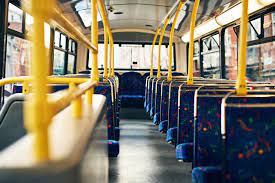Tips for taking public transit

Strong 8k brings an ultra-HD IPTV experience to your living room and your pocket.
Navigating Public Transit with Confidence: A Comprehensive Guide
Introduction:
Public transit is an essential component of urban life, offering convenience, cost-efficiency, and environmental benefits. Whether you're a seasoned commuter or a newcomer to the city, mastering the art of using public transit can significantly enhance your daily travels. This comprehensive guide provides valuable tips, tricks, and strategies to help you navigate public transit systems with confidence, making your journeys smoother, safer, and more enjoyable.
**1. Research and Planning:
Know Your Routes: Familiarize yourself with the routes, stops, and schedules of the public transit system in your city. Online maps, apps, and official websites are excellent resources.
Alternative Routes: Identify alternative routes and connections in case of delays, closures, or emergencies.
Peak and Off-Peak Hours: Plan your trips during off-peak hours to avoid overcrowding and potential delays.
Transit Apps: Utilize transit apps for real-time updates on routes, arrival times, and any service disruptions.
**2. Purchasing Tickets and Fare Options:
Ticket Options: Research available ticket types, such as single rides, daily passes, or monthly subscriptions. Choose the one that aligns with your travel frequency.
Payment Methods: Familiarize yourself with accepted payment methods, including contactless cards, mobile wallets, and transit-specific cards.
Exact Change: Carry exact change for cash payments to expedite the boarding process.
Transfers: Understand the transfer policy and time limits between different modes of transport.
**3. Safety and Etiquette:
Stay Alert: Be aware of your surroundings and belongings at all times. Avoid distractions like phones or headphones, especially in unfamiliar areas.
Boarding Etiquette: Allow passengers to exit before boarding. Make space for elderly, disabled, and pregnant passengers.
Priority Seating: Respect priority seating designated for those in need.
Emergency Procedures: Familiarize yourself with emergency procedures, exits, and safety features on vehicles and stations.
**4. Navigating Stations and Stops:
Signage and Maps: Pay attention to signage and maps within stations to find platforms, exits, and connecting lines.
Station Facilities: Explore station amenities such as restrooms, information kiosks, and vending machines.
Elevators and Escalators: Be mindful of using elevators and escalators properly, especially during peak hours.
Accessible Routes: Identify accessible routes for passengers with disabilities or strollers.
**5. Managing Transfers:
Transfer Times: Calculate transfer times accurately to avoid missing connections.
Platform Changes: Be prepared for platform changes when transferring between lines or modes of transport.
Intermodal Transfers: Understand the process of transferring between different types of transit, such as buses, trains, and trams.
**6. Dealing with Delays and Disruptions:
Realistic Timing: Factor in potential delays when planning your trips, especially during inclement weather or rush hours.
Service Updates: Stay informed about service disruptions through official channels, apps, or social media.
Backup Plans: Have contingency plans, such as ride-sharing services or walking routes, in case of severe delays.
**7. Communication and Interaction:
Asking for Help: Don't hesitate to ask station staff or fellow passengers for assistance if you're unsure about something.
Language Considerations: In multicultural cities, being aware of language differences can aid in communication.
Noise Levels: Keep conversations at a considerate volume to maintain a peaceful atmosphere.
**8. Environmental and Social Responsibility:
Reducing Footprint: Opt for public transit to contribute to reducing traffic congestion and carbon emissions.
Proper Disposal: Dispose of trash responsibly and respect the cleanliness of stations and vehicles.
Respect for Diversity: Show respect for diverse passengers by refraining from offensive language or behavior.
**9. Special Considerations:
Travelling with Children: Plan for children's needs, such as strollers or quiet activities.
Pets: Understand the transit system's policies on travelling with pets.
Luggage: Traveling with luggage? Check for luggage-friendly compartments or guidelines.
**10. Feedback and Improvement:
Providing Feedback: Share your experiences and suggestions with transit authorities for continuous improvement.
Advocacy: Get involved in local transit advocacy groups to contribute to positive changes in the system.
Conclusion:
Mastering the art of using public transit is a valuable skill that enhances your mobility and reduces the stress of commuting. By conducting thorough research, planning effectively, adhering to safety etiquette, and adapting to disruptions, you can navigate public transit systems with confidence. Remember that public transit is not just a mode of transportation; it's a way to connect with your city and contribute to a more sustainable future.
Navigating Public Transit with Confidence: A Comprehensive Guide
Introduction:
Public transit is an essential component of urban life, offering convenience, cost-efficiency, and environmental benefits. Whether you're a seasoned commuter or a newcomer to the city, mastering the art of using public transit can significantly enhance your daily travels. This comprehensive guide provides valuable tips, tricks, and strategies to help you navigate public transit systems with confidence, making your journeys smoother, safer, and more enjoyable.
**1. Research and Planning:
Know Your Routes: Familiarize yourself with the routes, stops, and schedules of the public transit system in your city. Online maps, apps, and official websites are excellent resources.
Alternative Routes: Identify alternative routes and connections in case of delays, closures, or emergencies.
Peak and Off-Peak Hours: Plan your trips during off-peak hours to avoid overcrowding and potential delays.
Transit Apps: Utilize transit apps for real-time updates on routes, arrival times, and any service disruptions.
**2. Purchasing Tickets and Fare Options:
Ticket Options: Research available ticket types, such as single rides, daily passes, or monthly subscriptions. Choose the one that aligns with your travel frequency.
Payment Methods: Familiarize yourself with accepted payment methods, including contactless cards, mobile wallets, and transit-specific cards.
Exact Change: Carry exact change for cash payments to expedite the boarding process.
Transfers: Understand the transfer policy and time limits between different modes of transport.
**3. Safety and Etiquette:
Stay Alert: Be aware of your surroundings and belongings at all times. Avoid distractions like phones or headphones, especially in unfamiliar areas.
Boarding Etiquette: Allow passengers to exit before boarding. Make space for elderly, disabled, and pregnant passengers.
Priority Seating: Respect priority seating designated for those in need.
Emergency Procedures: Familiarize yourself with emergency procedures, exits, and safety features on vehicles and stations.
**4. Navigating Stations and Stops:
Signage and Maps: Pay attention to signage and maps within stations to find platforms, exits, and connecting lines.
Station Facilities: Explore station amenities such as restrooms, information kiosks, and vending machines.
Elevators and Escalators: Be mindful of using elevators and escalators properly, especially during peak hours.
Accessible Routes: Identify accessible routes for passengers with disabilities or strollers.
**5. Managing Transfers:
Transfer Times: Calculate transfer times accurately to avoid missing connections.
Platform Changes: Be prepared for platform changes when transferring between lines or modes of transport.
Intermodal Transfers: Understand the process of transferring between different types of transit, such as buses, trains, and trams.
**6. Dealing with Delays and Disruptions:
Realistic Timing: Factor in potential delays when planning your trips, especially during inclement weather or rush hours.
Service Updates: Stay informed about service disruptions through official channels, apps, or social media.
Backup Plans: Have contingency plans, such as ride-sharing services or walking routes, in case of severe delays.
**7. Communication and Interaction:
Asking for Help: Don't hesitate to ask station staff or fellow passengers for assistance if you're unsure about something.
Language Considerations: In multicultural cities, being aware of language differences can aid in communication.
Noise Levels: Keep conversations at a considerate volume to maintain a peaceful atmosphere.
**8. Environmental and Social Responsibility:
Reducing Footprint: Opt for public transit to contribute to reducing traffic congestion and carbon emissions.
Proper Disposal: Dispose of trash responsibly and respect the cleanliness of stations and vehicles.
Respect for Diversity: Show respect for diverse passengers by refraining from offensive language or behavior.
**9. Special Considerations:
Travelling with Children: Plan for children's needs, such as strollers or quiet activities.
Pets: Understand the transit system's policies on travelling with pets.
Luggage: Traveling with luggage? Check for luggage-friendly compartments or guidelines.
**10. Feedback and Improvement:
Providing Feedback: Share your experiences and suggestions with transit authorities for continuous improvement.
Advocacy: Get involved in local transit advocacy groups to contribute to positive changes in the system.
Conclusion:
Mastering the art of using public transit is a valuable skill that enhances your mobility and reduces the stress of commuting. By conducting thorough research, planning effectively, adhering to safety etiquette, and adapting to disruptions, you can navigate public transit systems with confidence. Remember that public transit is not just a mode of transportation; it's a way to connect with your city and contribute to a more sustainable future.
Note: IndiBlogHub features both user-submitted and editorial content. We do not verify third-party contributions. Read our Disclaimer and Privacy Policyfor details.


